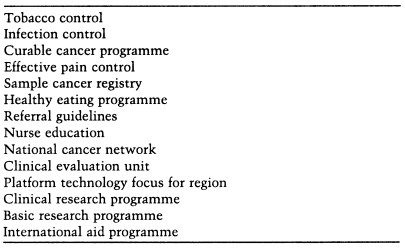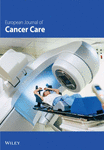WHO Programme on Cancer Control: developing a global strategy for cancer, a review
Amongst health care professionals nurses are perhaps more aware than many of the huge burden which cancer places on patients, on their families, and on society.
The WHO Cancer Unit was established in 1991 in Geneva, and began by concentrating on palliative care. More recently, cancer has featured more prominently and a move to Lyons, France, preceded the appointment of Professor Karol Sikora as Chief of the WHO Programme on Cancer Control.
Cancer statistics world wide make sombre reading. Across the world populations are ageing and age is one of the major risk factors for cancer. By 2020 there are likely to be 20 million new cancer patients every year. This will require a three-pronged approach: first, to develop prevention programmes; second, to introduce screening where this has been shown to be effective; and third, to spread knowledge and expertise to ensure the latest treatment modalities can be implemented. The underlying tenet that acknowledges palliative care as the basic right of all cancer patients-indeed of all patients-must continue to be strongly promoted.
The WHO Programme on Cancer Control has recently published a paper entitled ‘Developing a global strategy for cancer’. Prepared by Karol Sikora, this sets out the goals and the constraints, the resources, and the opportunities for all of us working in cancer care.
The rapidly rising incidence of cancer world wide can be laid at the door of success in eradicating such diseases as small pox, polio, and other infections. Action to control cancer must be taken in other ways. Tobacco, diet and infections, are all implicated in cancer incidence. Most urgently the use of tobacco needs to be controlled and, as a result, the annual cancer incidence could be reduced by 20%. How iniquitous that tobacco companies may well be promoting their products in the developing world in order to fund costs of litigation elsewhere. Advertising associates tobacco use with sex and success and the income generated may support an otherwise rocky economy. Only by concerted efforts will this escalation of tobacco use be broken and a significant reduction in tobacco use be achieved. Although most nurses may see themselves as providing care and support for patients, the educational element of their role must be increased and enhanced.
Increasingly in the developed world, more and more attention is being paid to what we eat and in what quantity. Sikora points out in his strategy document that a further 30% reduction in cancer incidence could be achieved through modifying diet. There are already widely published guidelines, for example, on avoiding animal fat, increasing fibre, reducing meat, increasing fruit and vegetables, and avoiding obesity.
Nutrition is increasingly seen as a key element of the nursing role and these messages need to be continually reinforced as nurses educate and advise their patients and families. Dietary advice and the ability to adhere to recommendations are inextricably linked with national economies and the political situation. The correct diet may not be affordable or available and there is still need for more definitive studies to provide the robust evidence that is needed.
Some of the greatest improvements in health have been through the global eradication of infections. Immunization and vaccination campaigns, often spearheaded by nurses, have made huge changes to mortality and morbidity rates. What is sometimes less well understood, is the fact that around 15% of cancer across the world is caused by infection and is therefore potentially preventable. Other organisms implicated in the development of cancers are indicated in the WHO strategy and include HBV in hepatoma, HPV in the cervix and anus, Helicobacter pylorii in the stomach, EBV in lymphoma and nasopharyngeal tumours, HIV in Kaposi’s sarcoma, and lymphoma and liver fluke in cholangiosarcoma.
In Europe and America, nurses have played a leading role in promoting screening for cervical dysplasia and are increasingly involved in managing precancerous changes and supporting women through the associated anxiety. There is a key role for nurses in providing education about lifestyle changes that can reduce the incidence of a wide range of cancers.
These three factors-tobacco, infections, and diet-contribute to the global incidence of some 7.5 million cancers. The establishment of targeted programmes world wide could be a cost-effective way of reducing the burden of care. Different countries have different needs and programmes can be tailored to the particular circumstances in each area.
Detecting cancer at an early stage when it is most amenable to treatment requires the concerted efforts of the whole health care team. Education is key. Education of the public and of the professionals. Early detection programmes utilising nurses are well established in many countries of the world.
The treatment of cancer-still principally managed with radiotherapy, chemotherapy and surgery-depends for its future development on laboratory research and greater understanding. Doubtless, there will be new systematic therapies, more precise radiation therapy, and cytotoxic drug regimes with less toxic unwanted side-effects. There are still huge differences around the world in the types of treatment available and the outcomes of therapies.
Cancer does not just cause physical effects. Increasingly psycho-social and palliative care are seen as essential rather than optional. Nurses have been at the forefront of promoting good care and support for cancer patients and have led many developments in palliative care. Communication and networking amongst nurses around the world can enhance these developments, supporting those nurses in countries where their professional position has yet to be recognized.
More information is available now than ever before. The Internet, for those who have access to it, provides a wealth of detail on all aspects of cancer. But this is available only to a small proportion of the world’s population. This is set to change and as a world wide information network becomes established, so too must an accurate database.
Teamwork is something of a buzzword now, but if cancer is to be tackled on a global basis there will be an urgent necessity for many groups and organizations to work together. For example, Union Internationale contre le cancer (UICC), European School of Oncology (ESO), and the National Cancer Institute (NCI) in America.
The WHO is to be congratulated on its stated aim of giving priority to the prevention and treatment of non-communicable diseases, of which cancer is one of the most widespread. Sikora’s paper highlights the fact that WHO is setting up 12 pilot projects with health ministries around the world. These will closely involve health professionals and encourage local enthusiasm and innovation. The WHO has developed a cancer priority ladder, which deserves the widest publicity (see Table 1).
In spelling out a strategy for cancer control world wide, Karol Sikora highlights the key role of nurses and nursing-not just in providing care and support, but in educating, leading and treating. They will take their place in the multiprofessional team needed to attack this global problem.
Karol Sikora’s strategy document gives us a blueprint for action. While recognizing the political, economic and cultural difficulties, there is nevertheless, action that can be taken now if we can demonstrate the will. He suggests a target of global cancer incidence reduction from 20 million to 15 million, and in the death toll from 10 million to 6 million. In the concluding worlds of this strategic document:
An effective strategy, political will, skilled persuasion, good media relations as well as international professional and industrial collaboration will be vital to achieve this target.





